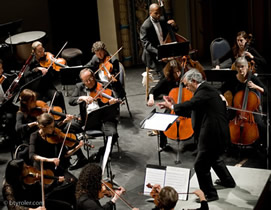Cleopatra, by Terpsicorps Theatre of Dance, Heather Maloy, artistic director, premiered Thursday night before a packed house in the Arts Council of Winston-Salem and Forsyth County’s Hanesbrands Theatre.
The company’s first full-length ballet since Dracula in 2011, Cleopatra is a feast for the senses and a delight for lovers of Maloy’s unstoppable imagination and her ability to bring it to fruition.
Cleopatra contains everything we have learned to expect from Terpsicorps since its inception in 2003: technically and artistically exceptional dancers, sensual and innovative movement, extraordinary use of music, gorgeous production values, and lots of surprises.
Hardly any figure in history has been as fetishized and mythologized as Cleopatra, the last pharaoh of ancient Egypt. Maloy’s ballet both fleshes out the very human woman and exalts the powerful ruler who was highly educated and ruthless in her pursuit of life and legacy. According to the program notes, she “was an expert on poisons and spoke 11 languages.”
At the beginning of the ballet, the death of Cleopatra’s father throws the governance of Egypt into question. The 18-year-old Cleopatra partners with her brother Ptolemy XIII to rule the land. Marriages between siblings were common among the Ptolemys who sought to keep their bloodlines pure. They were Greeks who had been put into power in Egypt by Alexander the Great.
Pothinus, a eunuch, was appointed to advise the young royals. Danced here with impressive power and gravitas by Jeff Ewing, Pothinus foolishly slays Pompey the Great, an ally of the new Roman leader Julius Caesar, thinking that Caesar will be pleased. He is not.
Dancing the role of Cleopatra, Madeline Bay was exquisite with gorgeous extensions and clear emotion. Most of the dancers perform in ballet slippers, but Bay’s performance was elevated by her use of toe shoes. She entered the stage alone but was soon joined by ensemble dancers processing down both aisles through the audience bearing flowers and censers. We were immersed in this strange, ancient world.
Cleopatra’s intention is to unite Egypt, at the time the world’s richest empire, with Rome, the world’s greatest military power; the two countries need each other.
She boldly travels to Rome to make an ally of Caesar. They fall in love and have a child together, while Caesar is still married to Calpurnia, danced with great delicacy by Betsy Lucas. Morgan Stillman performed the role of Caesar with an intriguing blend of sensuality and imperiousness. Stillman’s Caesar is a man’s man and a woman’s man too.
William Fowler gave a notable performance as Lepidas, who along with Octavian, Caesar’s son by Calpurnia, becomes part of the Second Triumvirate after Caesar is dramatically murdered. Marc Antony makes up the third leg of the Triumvirate.
Patricio DeStabile was deliciously devious as Octavian (Caesar’s son by Calpurnia), who is unexpectedly named Caesar’s heir. (He also dances Ptolemy XIII in Act 1.) Cleopatra is dismayed that the heir is not her son Caesarian.
David Ward, dancing the role of Marc Antony, is another wonderful dancer with powerful leaps that land in perfect silence. Cleopatra has a love affair with him that results in three more children.
Dancing Arsinoe, Florrie Sésé Geller brought great sympathy and pathos to the role of Cleopatra’s imperiled younger sister.
The ensemble pieces, which include a wild Lupercalia, an annual festival held to purify the city of Rome and promote health and fertility, were a delight. Dancers perform liquid lifts and interactions. Fights break out, orgies are hinted at, and over-indulgence in wine and food result in expectable retching. It’s all in the spirit of purification, right?
Be sure to read the program notes during the minutes before the performance begins. It’s a complicated plot and a brand-new ballet, so you can’t expect to know it as you know “Swan Lake.” The beauty of the production can be enjoyed without knowing exactly who’s who and what’s going on, but if you’re a person who likes to understand, the program notes explain it all for you.
All of the costumes designed by Jayne Harnett-Hargrove, and scenery designed by Sylvia Pierce are breathtakingly gorgeous. The set incorporates projections of scenes depicting ancient Rome and Egypt by Christian Faur. Moving lights on the still images hint at the flowing waters of the Nile River. Graphic symbols of Egypt, including the Eye of Horus, Anubis, a scarab beetle, and the Roman depiction of Romulus and Remus suckling the mother wolf are among the projections.
The lighting design by Joshua Paul Weckesser was completely brilliant. There were a few glitches among the hundreds of lighting changes on opening night, but these can be expected to be worked out in ensuing performances.
The finale features a dazzling array of projected images showing the countless ways that the Queen of the Nile has been depicted throughout history and popular culture, including Theda Barra, Elizabeth Taylor, and Sophie Okonedo, to name just a few.
Artistic Director Maloy grew up in Winston-Salem, attended UNC School of the Arts and danced for 13 years with the North Carolina Dance Theatre. That company, directed at the time by the late Sal Aiello, a teacher at UNCSA, moved from Winston-Salem to Charlotte in 1990, and Maloy debarked for Asheville in 2002.
For dancers, summertime brings a mixed bag. In the case of Terpsicorps, the off-season allows Maloy to hire top-tier dancers from places such as Oregon, Colorado, and California, who might otherwise not get work until the fall.
As a result, audiences in Asheville and Winston-Salem get to see some of the country’s most talented and beautiful dancers without leaving the comfort of home. Terpsicorps comes but once a year. Don’t miss this truly spectacular and moving production.
This performance runs through July 22. See our sidebar for details.











